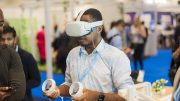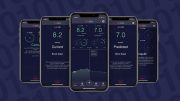With an increasingly ageing demographic, a significant public health challenge is the incidence of falls. Falls in the social care sector, after all, remain a major concern, with care home residents three times more likely to fall than their community-dwelling peers and 10 times more likely to sustain a significant injury, as a result.
However, without the proper care and supervision, residents who are known to be prone to falling, or who are at a greater risk of falling, should not be left unsupervised or allowed to mobilise on their own. The process is all about risk assessment and prevention.
Until recently, practically all fall prevention strategies throughout the social care sector relied heavily on human intervention; watching and assisting the vulnerable when they need to be mobile. Whether it’s a resident going to the toilet, entering the lounge, or going outside for some fresh air, caregivers had to persistently remain vigilant and on guard at all times, which can be difficult in large facilities and on a 24/7 schedule.
As with most of today’s professions and daily necessities, however, person-centred technology has completely transformed the dynamic when supporting people; alleviating pressures, improving time management and, in the social care sector, adding a layer of protection to resident health, safety and wellbeing.
There are now technologies widely available, such as Mobile Care Monitoring software, that promotes continued hydration by providing 24-hour monitoring of the amount of fluids offered and consumed for residents set up with a fluid ‘watch’. Moreover, the fluid targets can be personalised to individuals’ needs and preferences, with customer studies demonstrating a 33% reduction in falls.
Essentially, with the array of technology currently at our disposal, we want to reduce the stigma that has persisted around fall cases in UK care homes for far too long. With that in mind, it’s clear to see that the adoption of technology is a necessary step to achieve such a utopia.
At Madison Court, though the shift to a digital care management system was implemented only recently, the transformation was effortless. As we are a dementia home, the amount of work that came with keeping up with care records was nothing shy of overwhelming. However, in a short space of time, our staff have become extremely well equipped with the digital care technology and have seamlessly implemented it into their work routine.
Ultimately, what Mobile Care Monitoring gives you is a better standard of care. Instead of just getting our residents ready and changed for the day, we’ve suddenly got time to do their nails, talk and engage with them more, give them more TLC, as well as the opportunity to provide each resident with their own sense of belonging.
In addition, by utilising software to document residents’ intake of fluid in real-time, caregivers can immediately see which people haven’t had sufficient fluids and take the appropriate action required. The fluid offered to residents, and the amount drunk in millilitres can be easily evidenced at the point of delivery on mobile devices. Reminders to offer drinks can also be set up as part of a planned care routine.
Mobile Care Monitoring simplifies the process even further by using a traffic light system to alert staff when a care task is due or when a resident is falling below the recommended fluid threshold for the rolling 24-hour period and flagging the need for intervention.
By implementing innovative software to help prevent dehydration amongst residents, care homes can ensure resident hydration levels are kept replenished and, therefore, hospital admissions are less likely to be made. Also, with good hydration being a factor in preventing UTIs, low blood pressure and even more serious medical episodes such as seizures, the benefits of more efficient hydration management are vast. So, by providing caregivers with valuable fluid data, the chances of adverse incidents can be considerably reduced.
Furthermore, digital care technology can offer caregivers the ability to meticulously analyse any incidents, trace what actions led up to them and prevent further incidents from occurring. For example, at Maddison Court, we’re now able to spot patterns and adjust our practices to support residents better.
It’s clear to see that the collection of data can be of great assistance to caregivers and empowers staff to make responsive decisions that benefit everyone involved.
Moreover, the frequency of falling increases with age and can have serious consequences for older people. In fact, 35 per cent of people aged 65 and over who live in the community fall each year, increasing to 45 per cent for those 80 years and older (DH:2009). With that in mind, it’s clear that technology needs to be fully embraced if care providers are able to analyse any incidents, trace what actions led up to them and prevent future incidents from occurring. For example, by documenting incidents such as falls, care homes may be able to spot patterns and can adjust their practices to better support residents.
Ultimately, it’s the implementation of digital technology that helps to support care providers and improve the overall quality of care received by residents in an ever-expanding sector.
So, to anyone that is still hesitant or has trepidations about moving away from a paper-based approach, I would encourage you to really look at going digital. It’s no exaggeration to say that technology can quickly transform how you operate your care plan, as it’s done it for us in such a short amount of time. Everything is there to see in black and white, from reducing errors to saving time, and ultimately, it enables us to improve the overall quality of care to our residents.
About the author
Valerie Ann Carter is a Staff Nurse/Trainer at Madison Court Care Home, a purpose-built care home, very recently acquired by Harbour Healthcare. Person Centred Software was started in 2013 to help to improve the quality of life for people in social care. The company has become an award-winning global company with over 2,000 care homes in the UK alone, using their digital care system.





